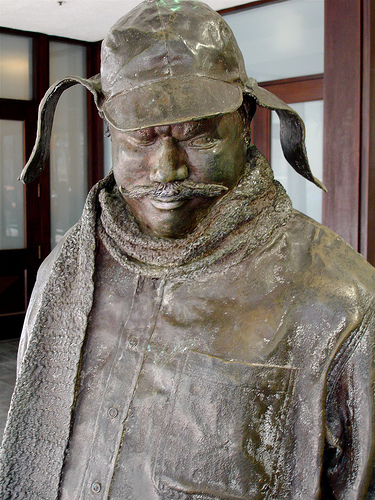 Ignatius J. Reilly never had very much patience or physical stamina, and yet he’s been standing at the foot of Canal Street in New Orleans for almost 50 years now, waiting to meet his alcoholic mother in front of what used to be the D.H. Holmes department store. In recent years, a bronze statue of the rotund and thoroughly self-involved protagonist of A Confederacy of Dunces has intermittently stood outside the old Holmes building – now the Chateau Bourbon – reminding passersby of author John Kennedy Toole’s opening chapter, set in the French Quarter of the early 1960’s. After a wild run-in with a policeman, Reilly and his mother duck into the Quarter’s squalid Night of Joy strip club for a drink, giving readers a seedy taste of the oldest good-times district in New Orleans. An annual reminder of the city’s 18th-century French roots is the Mardi Gras carnival – the destination of two chopper-riding drug smugglers in Easy Rider. Following their own run-in with some murderous hippy-haters outside of Morganza, bikers Billy and Wyatt decide to drown their sorrows at a grandly-appointed French Quarter brothel (really a Hollywood Hills mansion), containing a gilded ceiling fresco and the large portrait of a French dauphin. Filmed roughly five years after events in Dunces – wherein
Ignatius J. Reilly never had very much patience or physical stamina, and yet he’s been standing at the foot of Canal Street in New Orleans for almost 50 years now, waiting to meet his alcoholic mother in front of what used to be the D.H. Holmes department store. In recent years, a bronze statue of the rotund and thoroughly self-involved protagonist of A Confederacy of Dunces has intermittently stood outside the old Holmes building – now the Chateau Bourbon – reminding passersby of author John Kennedy Toole’s opening chapter, set in the French Quarter of the early 1960’s. After a wild run-in with a policeman, Reilly and his mother duck into the Quarter’s squalid Night of Joy strip club for a drink, giving readers a seedy taste of the oldest good-times district in New Orleans. An annual reminder of the city’s 18th-century French roots is the Mardi Gras carnival – the destination of two chopper-riding drug smugglers in Easy Rider. Following their own run-in with some murderous hippy-haters outside of Morganza, bikers Billy and Wyatt decide to drown their sorrows at a grandly-appointed French Quarter brothel (really a Hollywood Hills mansion), containing a gilded ceiling fresco and the large portrait of a French dauphin. Filmed roughly five years after events in Dunces – wherein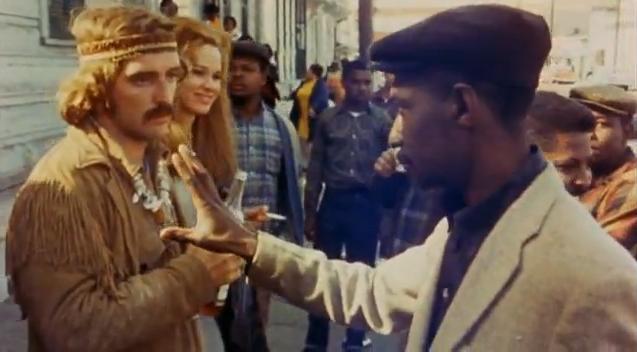 black janitor, Burma Jones works at the Night of Joy to avoid a vagrancy rap – Billy and Wyatt wander through 1968’s Mardi Gras amidst mostly-white revelers watching a number of black performers. Stepping away from the French Quarter’s main drag, though, the drunk-and-high buckskin-sporting Billy (liquor bottle and cigarette in-hand) is stopped by a more-dignified black pedestrian – the screen briefly filling with more black faces than at any other time during Rider’s picturesque journey through an American South emerging from the segregation of Jim Crow. Crossing Esplanade Avenue, just north of the Quarter, is a neighborhood born of racial tension. Faubourg Marigny sits on old plantation land carved up by wealthy English-hating French-Creole, Bernard de Marigny, who (to pay gambling debts) began selling property around 1806 to both whites and blacks (but only French-speaking Catholics) – including his slaveholding half-sister of color, Eulalie de Mandeville. Far from having to depend on the
black janitor, Burma Jones works at the Night of Joy to avoid a vagrancy rap – Billy and Wyatt wander through 1968’s Mardi Gras amidst mostly-white revelers watching a number of black performers. Stepping away from the French Quarter’s main drag, though, the drunk-and-high buckskin-sporting Billy (liquor bottle and cigarette in-hand) is stopped by a more-dignified black pedestrian – the screen briefly filling with more black faces than at any other time during Rider’s picturesque journey through an American South emerging from the segregation of Jim Crow. Crossing Esplanade Avenue, just north of the Quarter, is a neighborhood born of racial tension. Faubourg Marigny sits on old plantation land carved up by wealthy English-hating French-Creole, Bernard de Marigny, who (to pay gambling debts) began selling property around 1806 to both whites and blacks (but only French-speaking Catholics) – including his slaveholding half-sister of color, Eulalie de Mandeville. Far from having to depend on the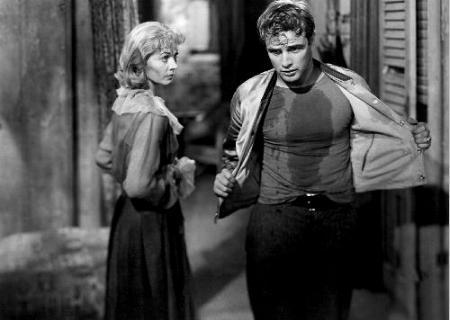 kindness of strangers, Mandeville made a fortune in dry goods and real estate – a far cry from the neediness Blanche DuBois has for sister, Stella in A Streetcar Named Desire. Much like Bernard de Marigny (who loathed Americans arriving after the Louisiana Purchase), Dubois can’t handle coarse newcomers, like brother-in-law Stanley Kowalski, changing her desired perception of an obsolete Creole-mannered Faubourg Marigny – even one where she too is only a visitor. Yet that’s nothing compared to living 200 years with no real home, as New Orleans-area indigo plantation owner, Louis learns the hard way in 1791, when he gets the taste for immortality in Interview With The Vampire. Turned by the vampire Lestat, Louis witnesses the evolution of the French Quarter’s narrow streets from the progenitor of New Orleans culture, to a late-20th century relic of his own long-passed youth. “This place is cursed, damned,” he tells the slaves burning down his house. “And, yes, your master is the devil!” Louis and Lestat then move their feast into the Quarter’s waterfront, and it’s there in 1955
kindness of strangers, Mandeville made a fortune in dry goods and real estate – a far cry from the neediness Blanche DuBois has for sister, Stella in A Streetcar Named Desire. Much like Bernard de Marigny (who loathed Americans arriving after the Louisiana Purchase), Dubois can’t handle coarse newcomers, like brother-in-law Stanley Kowalski, changing her desired perception of an obsolete Creole-mannered Faubourg Marigny – even one where she too is only a visitor. Yet that’s nothing compared to living 200 years with no real home, as New Orleans-area indigo plantation owner, Louis learns the hard way in 1791, when he gets the taste for immortality in Interview With The Vampire. Turned by the vampire Lestat, Louis witnesses the evolution of the French Quarter’s narrow streets from the progenitor of New Orleans culture, to a late-20th century relic of his own long-passed youth. “This place is cursed, damned,” he tells the slaves burning down his house. “And, yes, your master is the devil!” Louis and Lestat then move their feast into the Quarter’s waterfront, and it’s there in 1955 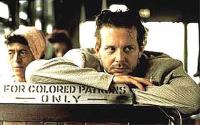 that private investigator, Harry Angel learns his connection with a man darkly indebted to the devilish Louis Cyphre in Angel Heart. Harry uncovers a wealth of moral corruption linked to one Johnny Favorite – born Valentine’s Day, 1918. Only a year prior, west of the Quarter across Basin Street, an era of legalized romantic corruption in the “Storyville” district was just ending. For twenty years, up until 1917, “The District” housed many city-sanctioned bordellos as an attempt at regulating prostitution. French director, Louis Malle re-examined the era through the eyes of 12 year-old Pretty Baby, Violet, who grows up in one such brothel as the daughter of a prostitute. When Violet asks photographer, Ernest Bellocq why he locks his doors, he replies “the neighborhood has turned bad,” and says it’s because of the same prostitutes he photographs to support himself. Yet after the calamity of Hurricane Katrina hit New Orleans in late 2005, film cameras were rolling as the city rebuilt itself from the latest bad turn – and it’s here that the story of Treme begins to unfold
that private investigator, Harry Angel learns his connection with a man darkly indebted to the devilish Louis Cyphre in Angel Heart. Harry uncovers a wealth of moral corruption linked to one Johnny Favorite – born Valentine’s Day, 1918. Only a year prior, west of the Quarter across Basin Street, an era of legalized romantic corruption in the “Storyville” district was just ending. For twenty years, up until 1917, “The District” housed many city-sanctioned bordellos as an attempt at regulating prostitution. French director, Louis Malle re-examined the era through the eyes of 12 year-old Pretty Baby, Violet, who grows up in one such brothel as the daughter of a prostitute. When Violet asks photographer, Ernest Bellocq why he locks his doors, he replies “the neighborhood has turned bad,” and says it’s because of the same prostitutes he photographs to support himself. Yet after the calamity of Hurricane Katrina hit New Orleans in late 2005, film cameras were rolling as the city rebuilt itself from the latest bad turn – and it’s here that the story of Treme begins to unfold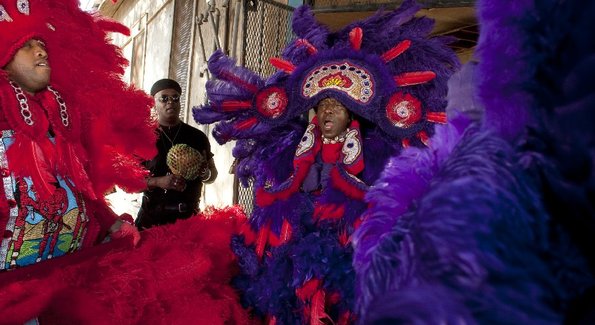 within Faubourg Tremé, just across North Rampart street from the Quarter. By 1810, Claude Tremé had sold many plots from his former-plantation to free blacks, while black slaves gathered in Congo Square on Sundays to dance and sing melodies fueled by African rhythms. Come carnival time, though, Treme‘s “Big Chief,” Albert Lambreaux evokes a more-local tribalism as head of the “Guardians of the Flame” Mardi Gras Indians. Their ritual costumes mask a complicated identity which they evoke with sacred songs like “Indian Red.” Yet it’s the brassy sounds of Jazz that set the tone of the series, defining each character (musician or not) in much the same way Toole wrote meticulously-worded dialogue to capture the distinct accents of all the New Orleans dunces confederated against Ignatius J. Reilly. When it comes to the voice of the Quarter, though, the accent will always come with a hint of French.
within Faubourg Tremé, just across North Rampart street from the Quarter. By 1810, Claude Tremé had sold many plots from his former-plantation to free blacks, while black slaves gathered in Congo Square on Sundays to dance and sing melodies fueled by African rhythms. Come carnival time, though, Treme‘s “Big Chief,” Albert Lambreaux evokes a more-local tribalism as head of the “Guardians of the Flame” Mardi Gras Indians. Their ritual costumes mask a complicated identity which they evoke with sacred songs like “Indian Red.” Yet it’s the brassy sounds of Jazz that set the tone of the series, defining each character (musician or not) in much the same way Toole wrote meticulously-worded dialogue to capture the distinct accents of all the New Orleans dunces confederated against Ignatius J. Reilly. When it comes to the voice of the Quarter, though, the accent will always come with a hint of French.
4 minutes read
The French Quarter(s), LA
4 minutes read